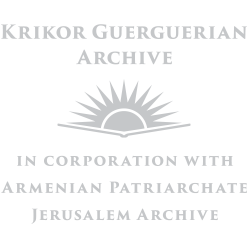The Ottoman records in the Krikor Guerguerian archive were taken from the archive of the Armenian Patriarchate and the Boghos Nubar Library in Paris. Documents that pertain to the court files from the prosecutions of the members of the Union and Progress Party in Istanbul, whose whereabouts are still unknown, are contained in the records that are part of the Armenian Patriarchate archive. Meanwhile, the records that were taken from the Boghos Nubar Library are the records that were sold by an Ottoman bureaucrat named Naim Efendi to Aram Andonian, an Armenian intellectual, in 1918.
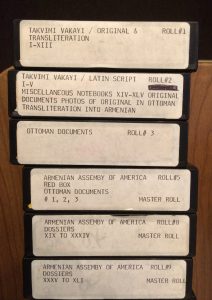 The Ottoman material in the Guerguerian Archive is priceless for its potential to help comprehend the Armenian genocide. The importance of this Archive is more than just the fact that it contains records which have heretofore been hidden from researchers working in the Prime Ministerial Archive or the ATASE (Presidential Office of the General Staff Military History and Strategic Studies) archive. Some of the records, especially the duplicates of the telegrams that were disclosed during the Istanbul prosecutions, can be found today in the Ottoman Archive. This fact alone is extremely important probative evidence of the authenticity of the records found in the Guerguerian Archive.
The Ottoman material in the Guerguerian Archive is priceless for its potential to help comprehend the Armenian genocide. The importance of this Archive is more than just the fact that it contains records which have heretofore been hidden from researchers working in the Prime Ministerial Archive or the ATASE (Presidential Office of the General Staff Military History and Strategic Studies) archive. Some of the records, especially the duplicates of the telegrams that were disclosed during the Istanbul prosecutions, can be found today in the Ottoman Archive. This fact alone is extremely important probative evidence of the authenticity of the records found in the Guerguerian Archive.
The most important feature of the records is the fact that they reveal that the Armenians were systematically annihilated.
The Physical Attributes of the Records
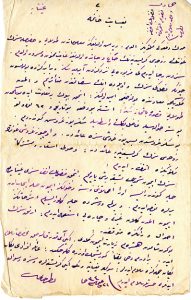
The Ottoman material is comprised of records and/or duplicates of records. While some of the governmental correspondence are on signed and sealed letterhead stationary, others appear to be duplicates of originals. A document that we have identified as a “Duplicate of Record”, is often something that was written on a tiny section of paper or even a school notebook, because of the difficulties of creating copies at that time.
We took the Guerguerian Archive records, that were scattered and lacking in any systematic order, and organized them by subject matter and created a detailed index for it. In this way, we have made it possible for researchers to easily find a document, based on key words or subjects, by searching the index.
There are many examples, in the archive, of a record showing up several times, repeatedly, in different media format, such as a photocopy, microfilm etc. We organized these many duplicate examples and present them here together. The publication of the same document in different visual media adds tremendously to the ability of the reader to understand the document, especially those that are often difficult to make out due to issues around legibility.
The Classification of the Records and Cataloguing
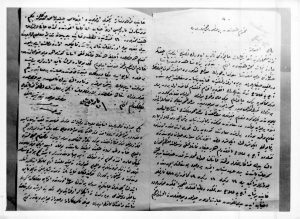
In the classification of the records, we felt it was useful to divide them up by city. The reasoning behind this was that the prosecutions in Istanbul had been identified by city, at the time. Records that were not directly related to a certain city or hearing were organized according to individuals or subject matter (Like Vehip Pasha, Krikor Zohrab or Deportation Practices etc.)
One of the issues we confronted when dividing up the records by subject matter was that many of the records had been placed together in notebook fashion and the same notebook sometimes held records pertaining to disparate subjects. In this situation, we decided to place the notebook with whichever subject matter was the most dominant one. Any issues that might be confronted with this arrangement are mitigated by the use of an index to search for records.
Some Classification Challenges
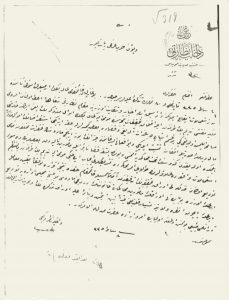
The areas of jurisdiction between Ottoman civil and administrative organization during the latter years [Province/Provincial district/County/Township/village and/or borough] and military organization [army/army corps/divison etc.] did not correspond evenly and resulted in discrepancies. For example, one unit of the Army Corps could be responsible for the counties and townships within two separate provinces. These differences in the areas of jurisdiction of the military organization created some issues when classifying the records.
We would like to provide two examples for purposes of illustration:
The first has to do with the caravans that were dispatched from Trabzon. The Trabzon caravans were captured and massacred in the regions of Giresun and Erzincan. After the incident came to light, the suspects were prosecuted in the region of Erzincan. For this reason the records pertaining to this, either Trabzon or Giresun, were placed under the “Erzincan Binder”.
The second pertains to the deportation and massacres that occurred from Yozgat. The military units that were responsible for this deportation followed a series that encompassed the Ankara Army Corps, Kayseri Division and Boğazliyan Military Branch. A different extension of the same series encompassed Kastamonu, Kirşehir and Eskişehir. The incidents that were covered in the records come within the Ankara Army Corps, when viewed most broadly and looking at the military organization. However, since the subject ended up being prosecuted as part of the Yozgat trial in Istanbul, we felt it was best to arrange those records under the “Yozgat Binder” heading.
Outside of these, if the records were directly related to a particular person, even if they took place in different cities, they were classified under that person’s name. Vehip Pasha and Kriker Zohrab are two examples of when this was done. Records that could not be classified by place or individual were classified, as much as possible, according to subject matter: Armenian Patriarchate, Inspection Practices etc.
Information Regarding the Files that are arranged By Binders:
-
Adana:
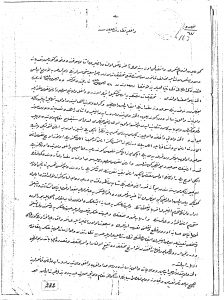
Thirteen records making up a total of eleven files were placed here. Most of the records relate to the organization of the Hunchaks in the region. Along with this, one can find correspondence over the demands for reforms after the events of 1909.
-
Bitlis:
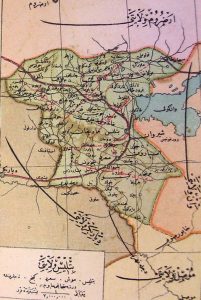 There are two separate records pertaining to incidents like murder or capture of Armenians in the province prior to the mobilization.
There are two separate records pertaining to incidents like murder or capture of Armenians in the province prior to the mobilization.
-
Çankırı:
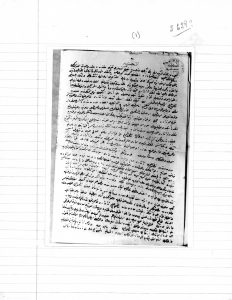 The complete text of the indictment, prepared against Cemal Oguz, the responsible secretary of the Union and Progress party in the township of Cankiri.
The complete text of the indictment, prepared against Cemal Oguz, the responsible secretary of the Union and Progress party in the township of Cankiri.
-
Dersim:
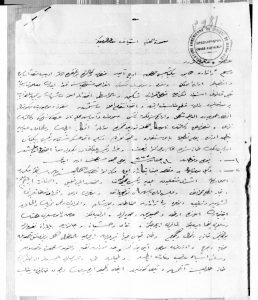
Two records in two files can be found and they relate to the events in the region during the deportation and the corruption of the deputy provincial district governor and the Mayor.
-
Diyarbakir:
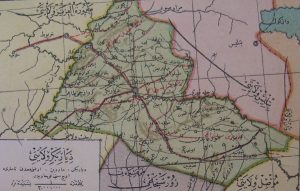
There are eleven records within six files and they relate to the Provincial District Governor of Zor, Zeki Bey and the Governor-General Reşit Bey.
-
Erzincan:
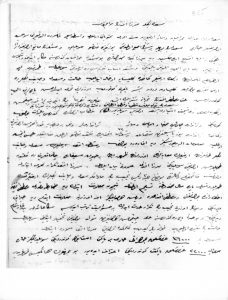
This binder contains 22 files comprised of 116 records. All of the records pertain to the sacking and murders of the caravans which left Trabzon and Erzurum. A military tribunal was formed and an investigation was pursued on the subject.
-
Izmit:
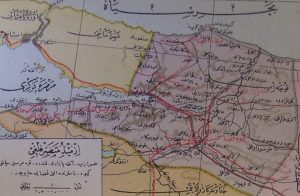
This binder consists of five records in five files and covers the events that occurred after 1918.
-
Konya:
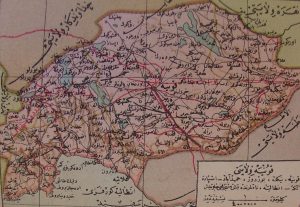
This binder consists of seven files with fourteen records. For the most part, it is comprised of certified copies of coded telegrams sent by Talat Pasha. Almost all of these records can be found in the Ottoman Archive today.
-
Malatya:
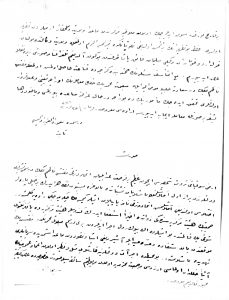
This consists of information, according to the civilian divisions of the period, about the caravans that passed through Malayta, Hisnimansur and Besni during the deportation. There are fifteen records in four separate files here.
-
Sivas:
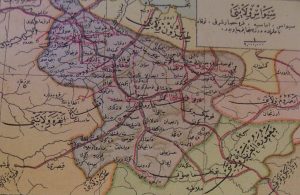
There are in total 80 records in the 24 files that make up the Sivas binder. Most of the records pertain the murder of Sahak Odabashian, who was a delegate from Bursa who had been assigned to Erzincan, and the records consist of the correspondence and sworn testimonies that were recorded. Additionally, subjects such as the murder of the students and teachers of the Sanasarian School, the destruction of the Armenian Church and Armenian homes and villages in Sivas and the construction of a Unionist club and hotel from the stones of the latter structures, are touched upon.
-
Yozgat:

The most comprehensive binder of Ottoman records in the Guerguerian Archive is the one on Yozgat. The copies of correspondence pertaining to the deportation and related killings from Yozgat, along with the deportations and killings that pertain to Ankara, Kayseri and Çorum are in this binder. The court ruling on the Çankırı [Chankiri] matter is also found here. There are 71 files and 361 records in the Yozgat binder.
-
Fazıl Bey:
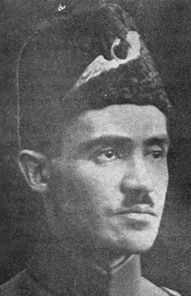
Fazıl Bey, who was from Malatya and had retired from being a Captain in the army, produced a list of the incidents that occurred in Malatya and its environs involving the Armenians and submitted them to the authorities in Istanbul.
-
Krikor Zohrab:
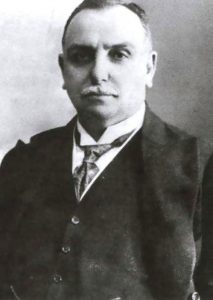
This consists of five files with five records which pertain to the correspondence and reports that were issued between Urfa, Aleppo and Istanbul following the murder of Zohrab Efendi.
-
Naim Andonian:
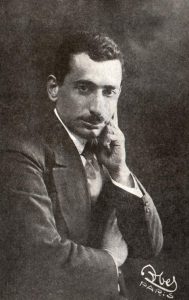
It contains the scanned images of the documents that were sold to Andonian by Naim Efendi, which are found in the Guerguerian archive, total 11 items.
-
Vehip Pasha:
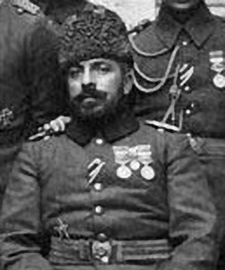
Vehip Pasha provided written testimony to a Military Tribunal and later provided written answers to interrogatories. There are three records in two files.
-
Yervant Odian:
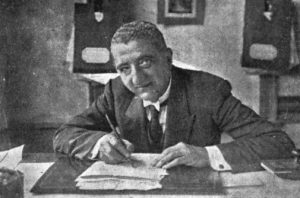
The writings of Yervant Odian on Muslim-Christian and particularly Turkish-Armenian relations can be found in this binder. In the writings, as a matter of general state policy, Ottoman citizenship is described through examples of treatment extended to non-Muslim segments of society, meanwhile touching upon the deportation from Yozgat. Additionally, in this section, there are two letters that were sent to the Jamanak newspaper for publication, by Armenian women from Ankara. There is a total of five files with five different records.
-
Court Justices and Prosecutors:
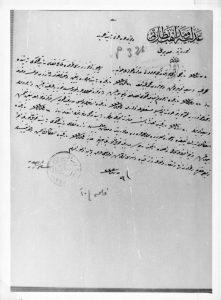
There are four files and four records which comprise this binder that is filled with the files and related correspondence around the judicial personnel assigned to the provinces, districts and counties, including their names, appointments, and dates of discharge with explanations, during the deportation process, starting from 1914.
-
Military Tribunal Various Subjects:
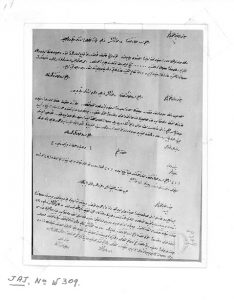
There are 21 separate records pertaining to court petitions, permission records and correspondence located in 21 files under this heading.
-
Patriarchate – Catholicosate:
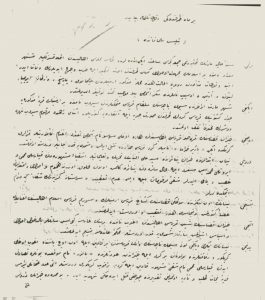
This binder consists of copies of letters that were either sent by Catholicos Sahak Efendi or that were sent to him. A large percentage of the letters were sent to Cemal Pasha, the Patriarchate, the Governor General of Adana and the District Governor of Kozan. There are 26 records in the 24 files.
-
Inspection Reports:
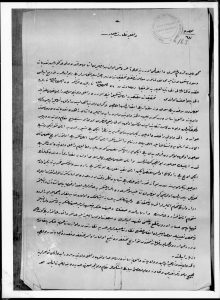
This binder consists of the reports prepared by inspectors who were sent to perform follow up, after receiving news, on the regions where Armenians had been transported during the deportation of 1915. The inspections of Adana, Marash, Deir Zor, Damascus, Diyarbekir and the district of Malatya along with the inspections of the County Executive of Kahta and records revolving around the murder of Nesim Bey are found here. There are fourteen records in fourteen files.
-
Deportation Practices:
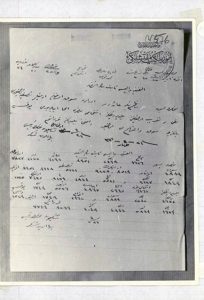
This binder consists of copies of correspondence pertaining to the deportations and killings in general without distinction as to civilian or military region. There are 38 records found within the 33 files that make up this binder.
-
Governors – County Executives:
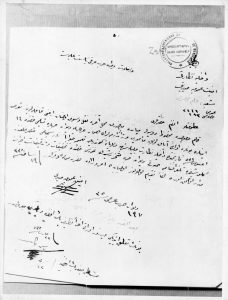
One of the files in the binder pertains to the mobilization and the names, assignments and dates discharged from duty with explanations, for governors general and county executives who were in charge during the war years. The other files pertain to different personalities like Reşit, the Governor general of Diyarbekir, and Suat, the District Governor of Deir Zor. There are eleven records in seven files that make up this binder.
